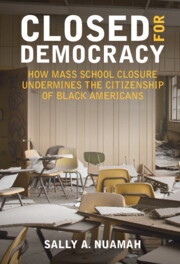Book contents
- Closed for Democracy
- Closed for Democracy
- Copyright page
- Epigraph
- Contents
- Figures
- Tables
- Acknowledgments
- Introduction: Closed for School, Open for Business
- 1 What Targeted Citizens Think
- 2 Who Targeted Citizens Blame
- 3 How Targeted Citizens Fight Back
- 4 Who Wins and Who Loses in the Era of Mass School Closures
- Conclusion: Closed for School, Closed for Democracy
- Epilogue: Close to Home
- Appendix
- Bibliography
- Index
3 - How Targeted Citizens Fight Back
Participating While Poor and Black in the Policy Process
Published online by Cambridge University Press: 11 March 2023
- Closed for Democracy
- Closed for Democracy
- Copyright page
- Epigraph
- Contents
- Figures
- Tables
- Acknowledgments
- Introduction: Closed for School, Open for Business
- 1 What Targeted Citizens Think
- 2 Who Targeted Citizens Blame
- 3 How Targeted Citizens Fight Back
- 4 Who Wins and Who Loses in the Era of Mass School Closures
- Conclusion: Closed for School, Closed for Democracy
- Epilogue: Close to Home
- Appendix
- Bibliography
- Index
Summary
Chapter 3 examines how the closure process facilitates increased participation of affected citizens at the local level, in part, through the channeling of resources by the school district, which wants to be perceived as collecting community input. The resources provided by the district and community organizations facilitate increased protests of closure decisions. From their actions, this chapter demonstrates that affected citizens become the most likely group to attend a community meeting, to support an elected school board, and to turn out to vote. And yet, in the end this chapter raises the question of whether their actions lead to lasting policy change.
Keywords
- Type
- Chapter
- Information
- Closed for DemocracyHow Mass School Closure Undermines the Citizenship of Black Americans, pp. 85 - 108Publisher: Cambridge University PressPrint publication year: 2022

